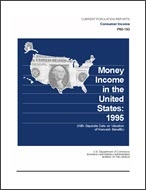Money Income in the United States: 1995 (With Separate Data on Valuation of Noncash Benefits)
Money Income in the United States: 1995 (With Separate Data on Valuation of Noncash Benefits)
Note: Comparability of the 1995 income data with data from previous Current Population Survey (CPS) years is affected by three changes in survey methodology: (1) complete phasing in of the 1990 census-based sample design, (2) reduction of the CPS sample by about 7,000 households, and (3) a revised edit and allocation procedure for the race item. For more information regarding these changes, see page xvii.
The CPS is probably the best known and most widely used of all continuing Federal household surveys. Daily news (whether television, radio, or newspaper) frequently details statistics on Americans’ jobs, income, poverty status, health, and so forth using CPS data. For almost 50 years, analysts, researchers, and policymakers have also used CPS data to examine annual changes in income and earnings and to compare these changes with historical trends. This year’s report shows that the economic status of households in the United States is improving and that selected subgroups have experienced recent economic gains which have raised their incomes to 1989 prerecessionary levels. As an added feature this year, data on income by nativity of the householder are presented for the first time in the consumer income report series.
Highlights
(The figures in parentheses denote 90-percent confidence intervals.)
- For the first time in 6 years, households in the United States experienced an annual increase in real/1 median income. Between 1994 and 1995, median household income increased by 2.7 (± 1.0) percent from $33,178 (± $257) to $34,076 (± $324). See tables A and B–2.
- The Midwest region was the only region to experience a significant change in real median household income between 1994 and 1995, increasing from $33,426 (± $546) to $35,839 (± $586). (See table A.) This is the first annual increase in median household income experienced by the Midwest since 1988.
- White and Black households experienced increases in real median income between 1994 and 1995—the income of White households increased by 2.2 (± 1.0) percent to $35,766 (± $306), for Black households the increase was 3.6 (± 3.5) percent to $22,393 (± $628).2 In contrast, the median income of Hispanic-origin households declined by 5.1 (± 3.6) percent to $22,860 (± $819) between 1994 and 1995.3 The income of Asian and Pacific Islander households in 1995, $40,614 (± $1,676), was not significantly different from its 1994 level. See table A.
- Households located both inside and outside metropolitan areas experienced increases in real median income between 1994 and 1995. Households located inside metropolitan areas experienced an increase of 2.4 (± 1.2) percent to $36,079 (± $326). Households outside metropolitan areas experienced an increase of 2.9 (± 2.8) percent to $27,776 (± $661).4 See table A.
- The annual real median earnings of women working year round, full time declined $337 or 1.5 (± 1.1) percent between 1994 and 1995—going from $22,834 (± $193) to $22,497 (± $225). The earnings for men working year round, full time, $31,496 (± $189), remained unchanged. See table A. The female-to-male earnings ratio in 1995 was .71, not statistically different from the all-time high ratio reached in 1990.
- Per capita income did not change in real terms between 1994 and 1995 for the total population or for race and Hispanic-origin groups. See table A.
- There was no change in overall income inequality between 1994 and 1995. See table B-3.
- Based on comparisons of 2-year moving averages, real median household income increased significantly for 11 states—Colorado, Illinois, Iowa, Kentucky, Maine, Mississippi, Missouri, Pennsylvania, Tennessee, Texas, and Wisconsin. The remaining 39 States and the District of Columbia showed no significant change. See table C.
- The use of a fully adjusted income definition (one that includes the effect of taxes and noncash benefits) lowered income inequality by 11.3 (± 1.0) percent. Government transfers have a much more significant effect than taxes on redistributing income.
- The change in household median income between 1994 and 1995 using the fully adjusted income definition was 2.6 (± 0.8) percent, not significantly different from the change in official money income.
- The use of a definition of income that has been broadened to include the effect of taxes and noncash benefits results in higher Black-to-White and Hispanic-to-White household income ratios.
__________
1 Changes in real income refer to comparisons after adjusting for inflation. The percentage changes in prices between earlier years and 1995 were computed by dividing the annual average Consumer Price Index (CPI-U) for 1995 by the annual average for earlier years. See table B–1 in appendix B for the CPI-U’s from 1947 to 1995.
2 The difference between the percentage changes in the median income of White and Black households was not statistically significant.
3 The difference between the median incomes of Black and Hispanic-origin households was not statistically significant.
4 The difference between the percentage changes in the median income of metropolitan and nonmetropolitan households was not statistically significant.
Tables
Graph
Press Briefing
Historical Data
Table
Table
Table
Table
Table
Detailed Tables
Table
Table
Table
Others in Series
Publication
Publication
Publication









